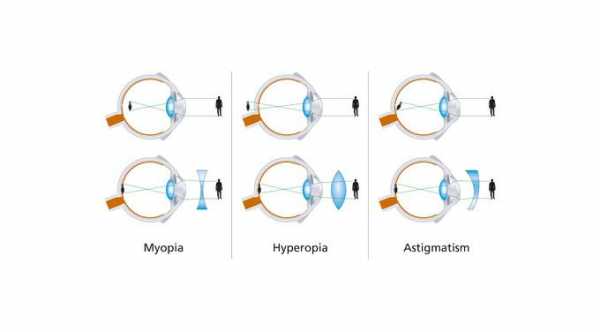
Refractive Errors: Myopia, Hyperopia and Astigmatism
Vision occurs when rays of light are refracted as they pass through the cornea (dome-like transparent layer in front of the eye that covers the pupil, iris, and anterior chamber), into the lens, and then are focused on the retina which in turn transmits signals to our brain.
A defect in the capacity of the eye to normally bend light due to irregularities in the shape of the eye, cornea or lens, is called a refractive error.
The primary refractive errors are Hyperopia (farsightedness), Myopia (nearsightedness) and Astigmatism.
Myopia
Myopia or nearsightedness is a condition where objects up close appear clear, while distant objects appear blurry. This happens when the length of eye globe is longer than the normal length or the curvature of the cornea is steeper than normal. As a result, the light rays and images are not focused in the retina but infront of the retina.
Hyperopia
Hyperopia or farsightedness is a condition where distant objects appear clearer than near objects. This happens when the eyeball is too short or if the cornea is flatter or has lesser curvature than normal. As a result, the light rays are focused behind the retina instead on the retina.
Astigmatism
Astigmatism is a distortion in both near and far vision. This happens when there is an irregularity in the curvature of the cornea (corneal astigmatism) or in the shape of the eye’s lens (lenticular astigmatism). As a result, the light rays are not focused on a single point on the retina.
Treatments of Refractive errors
Refractive errors can be treated with eyeglasses, contact lenses, or surgery.
Eyeglasses
The type of lens depends on the type of refractive error.
Minus lens – A concave or minus lens is used to treat myopia. A concave lens has a thin center and thicker edges. When using a concave lens, the light rays spread out (diverge) as it pass through the lens which corrects nearsightedness.
Plus lens – A convex or plus lens is used to treat hyperopia. A convex lens has a thick center and thinner edges. When using a convex lens, the light rays bend inwards (converge) as it pass through the lens which corrects farsightedness.
Cylinder lens – A cylinder lens is used to treat astigmatism. A cylinder lens contains 2 refractive powers; 1 that is applied on the entire lens, and 1 applied in one direction or axis.
Contact lenses
Unlike eyeglasses, contact lenses are placed directly on the cornea and are held in place naturally by the eye. Because of this vision is clearer compared to eyeglasses. However, not everyone is a candidate for contact lens use. Care and maintenance also require stricter compliance.
Soft contact lens – These are made of flexible plastic. Easier to use, more comfortable, and less likely to be dislodged compared to hard lenses.
Hard contact lens – Hard contact lenses, also known as Rigid Gas Permeable (RGP), are now made of durable plastic but were originally made of Polymethyl methacrylate (PMMA). It is more durable and it provides clearer vision compared to soft lenses. It is preferred for high astigmatism correction such as in those with Keratoconus.
Refractive Surgery
Refractive surgeries are surgical procedures that correct refractive errors by reshaping the cornea. A series of tests are made prior to surgery in order to assess the client’s eligibility, as well as to come up with a list of options that can be recommended to the client.





